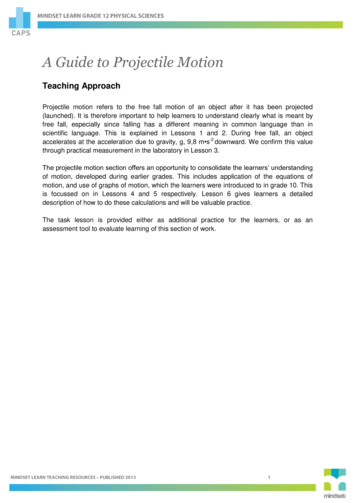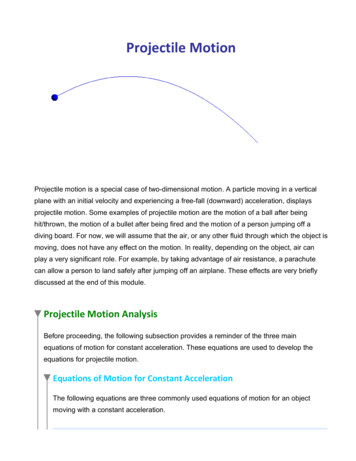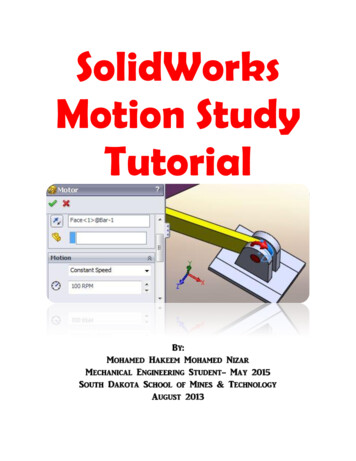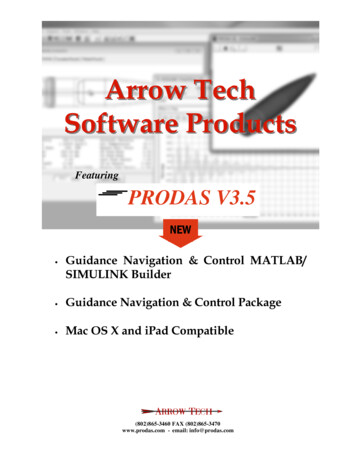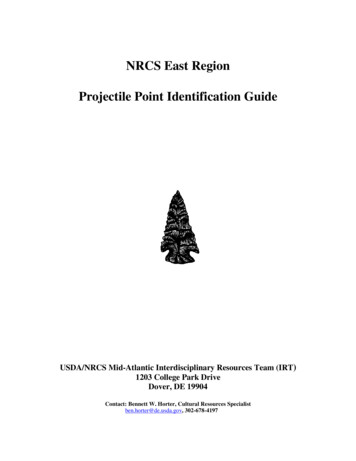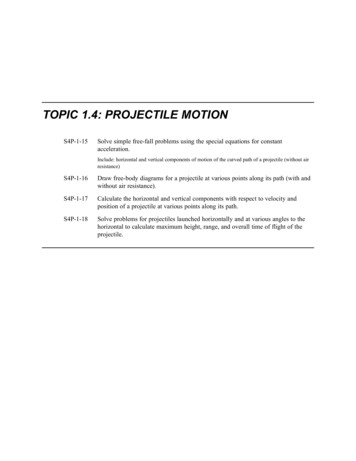
Transcription
TOPIC 1.4: PROJECTILE MOTIONS4P-1-15Solve simple free-fall problems using the special equations for constantacceleration.Include: horizontal and vertical components of motion of the curved path of a projectile (without airresistance)S4P-1-16Draw free-body diagrams for a projectile at various points along its path (with andwithout air resistance).S4P-1-17Calculate the horizontal and vertical components with respect to velocity andposition of a projectile at various points along its path.S4P-1-18Solve problems for projectiles launched horizontally and at various angles to thehorizontal to calculate maximum height, range, and overall time of flight of theprojectile.
Topic 1: Mechanics SENIOR 4 PHYSICSGENERAL LEARNING OUTCOMECONNECTIONStudents will Recognize both the power and limitationsof science as a way of answeringquestions about the world and explainingnatural phenomena (GLO A1)SPECIFIC LEARNING OUTCOMES4P-1-15: Solve simple free-fallproblems using the special equationsfor constant acceleration.Include: horizontal and verticalcomponents of motion of the curved pathof a projectile (with or without airresistance)SUGGESTIONS FOR INSTRUCTIONEntry Level KnowledgeThe special equations for constant acceleration arecovered in Topic 1 and students are familiar withfree fall from Senior 3 Physics.Notes to the TeacherSolve various problems using the derivedkinematic equations, given the a g –9.8 m/s2.The problems should include when the initialvelocity is zero (dropped object), the initialvelocity is positive, and the initial velocity isnegative. A common student difficulty isrecognizing that an object at its maximum heightstill has an acceleration of –9.8m/s2 although itsinstantaneous velocity is zero.FGFGThe Force of Gravity Is Always ConstantF ma38 – Topic 1.4 Projectile MotionFGAnother student difficulty is when an object is in asystem that is moving at a constant velocity (i.e.,rising) and the object is released. Students tend tobelieve the initial velocity of the object is zero, butit actually is the velocity of the moving system.Additionally, when an object is thrown upward andreturns to its original position, the displacement ofthe object would be zero when applying thekinematics equations.Collaborative TeamworkStudents are given a simple free-fall problem toresolve in a group and then present the solution tothe rest of the class.
SENIOR 4 PHYSICS Topic 1: MechanicsSKILLS AND ATTITUDES OUTCOMES4P-0-2g: Develop mathematicalmodels involving linear, power,and/or inverse relationshipsamong variables.SUGGESTIONS FOR INSTRUCTIONGENERAL LEARNING OUTCOMECONNECTIONStudents will Recognize that characteristics ofmaterials and systems can remainconstant or change over time, anddescribe the conditions and processesinvolved (GLO E3)SUGGESTIONS FOR ASSESSMENTPencil-and-Paper TasksTeachingNotesStudents solve problems for free fall using thespecial equations of motion.Topic 1.4 Projectile Motion – 39F ma
Topic 1: Mechanics SENIOR 4 PHYSICSSPECIFIC LEARNING OUTCOMESGENERAL LEARNING OUTCOMECONNECTIONStudents will Recognize that scientific knowledge isbased on evidence, models, andexplanations, and evolves as newevidence appears and newconceptualizations develop (GLO A2)S4P-1-16: Draw free-body diagramsfor a projectile at various pointsalong its path (with or without airresistance).S4P-1-17: Calculate the horizontaland vertical components withrespect to velocity and position of aprojectile at various points along itspath.SUGGESTIONS FOR INSTRUCTIONEntry Level KnowledgeClass ActivitiesVector components are addressed in the Topic 1.2(Dynamics) and simple free-body diagrams arecovered in Senior 3 Physics.Review qualitatively, with the aid of diagrams, thehorizontal and vertical velocities, and acceleration.Observe a projectile with a stroboscope and recordon a video camera to analyze with computersoftware or VCR. Show Vertical and HorizontalMotion from the videodisc Physics: CinemaClassics. This gives an excellent demonstration ofthe independence of these two motions.Notes to the TeacherStudents must be aware that the horizontal andvertical motions are independent of each other. Toreinforce these concepts, it is useful to draw freebody diagrams. The horizontal motion is a uniform(constant) motion and the vertical motion is auniformly accelerated motion (a –9.8 m/s2). Thenet force (Fg) acting on the projectile is constant(neglecting air resistance).If air resistance is taken into consideration, thefrictional force will always be in the oppositedirection to the velocity (tangential to the path).The frictional force will decrease the horizontal aswell as the vertical components of velocity. Theresulting path will be asymmetrical. Studentsshould only analyze this type of projectionqualitatively, not quantitatively.FairFGFairFGFairFGStrobe of free fall and projectileProjectile with Air ResistanceF ma40 – Topic 1.4 Projectile Motion
SENIOR 4 PHYSICS Topic 1: MechanicsSKILLS AND ATTITUDES OUTCOMEGENERAL LEARNING OUTCOMECONNECTIONS4P-0-2f: Record, organize, anddisplay data using an appropriateformat.Students will Demonstrate appropriate scientificinquiry skills when seeking answers toquestions (GLO C2)Include: labelled diagrams, tables,graphsDemonstrate appropriate problemsolving skills while seeking solutions totechnological challenges (GLO C3)SUGGESTIONS FOR INSTRUCTIONSUGGESTIONS FOR ASSESSMENTStudents should be careful to differentiate betweenforce and velocity vectors. A blackline master ofthe strobe photo is included in Appendix 1.7 forcopying.initial velocity v1 vxvyXverticalcomponentof velocityPencil-and-Paper TasksDraw free-body diagrams of a projectile at variouspoints on its path, using vectors to represent thehorizontal and vertical velocities.Calculate the horizontal and vertical componentsof position and velocity.horizontalcomponentof velocityvxvDetermine the net force, position, and velocityvectors.resultantvelocity ofball at Point XVx VVyVVxVxViVyVVyVxVxVyVTopic 1.4 Projectile Motion – 41F ma
Topic 1: Mechanics SENIOR 4 PHYSICSSPECIFIC LEARNING OUTCOMESGENERAL LEARNING OUTCOMECONNECTIONS4P-1-16: Draw free-body diagramsfor a projectile at various pointsalong its path (with or without airresistance).Students will Recognize that scientific knowledge isbased on evidence, models, andexplanations, and evolves as newevidence appears and newconceptualizations develop (GLO A2)S4P-1-17: Calculate the horizontaland vertical components withrespect to velocity and position of aprojectile at various points along itspath.SUGGESTIONS FOR INSTRUCTIONDemonstrationsAn air table, inclined at an angle, can demonstratethe motion of a projectile. A stream of water canalso demonstrate trajectories associated with initialangles of launch.Place two coins on the edge of a table, with oneplaced above the other (see diagram). Launchobjects simultaneously off the edge of a table usinga flexible ruler. The coin further out will have agreater velocity and therefore a greater range, butboth coins will land on the floor at the same time.Have students observe this demonstration visuallyand by listening to the sound of the ruler strikingthe coins and the coins striking the ground. Usingthe diagrams provided, students measure thehorizontal and vertical displacement for each timeinterval. Students reach the conclusion that thehorizontal velocity component is constant and thevertical component of velocity increases/decreasesthe same as an object in free-fall motion.clamp to stop ruler1Vix1I2IrulerVix2As seen from the side.F ma42 – Topic 1.4 Projectile Motioncoin 1coin 2
SENIOR 4 PHYSICS Topic 1: MechanicsSKILLS AND ATTITUDES OUTCOMES4P-0-2f: Record, organize, anddisplay data using an appropriateformat.Include: labelled diagrams, tables,graphsGENERAL LEARNING OUTCOMECONNECTIONStudents will Demonstrate appropriate scientificinquiry skills when seeking answers toquestions (GLO C2)Demonstrate appropriate problemsolving skills while seeking solutions totechnological challenges (GLO C3)SUGGESTIONS FOR INSTRUCTIONSUGGESTIONS FOR ASSESSMENTTeachingNotesTopic 1.4 Projectile Motion – 43F ma
Topic 1: Mechanics SENIOR 4 PHYSICSGENERAL LEARNING OUTCOMECONNECTIONStudents will Demonstrate appropriate critical thinkingand decision-making skills when choosinga course of action based on scientific andtechnological information (GLO C4)SPECIFIC LEARNING OUTCOMESKILLS AND ATTITUDES OUTCOMESS4P-1-18: Solve problems forprojectiles launched horizontallyand at various angles to thehorizontal to calculate maximumheight, range, and overall time offlight of the projectile.S4P-0-2b: Propose problems,state hypotheses, and plan,implement, adapt, or extendprocedures to carry out aninvestigation where required.S4P-0-2d: Estimate and measureaccurately using SI units.SUGGESTIONS FOR INSTRUCTIONEntry Level KnowledgeLaboratory ActivitiesEquations for constant acceleration are covered inTopic 1 and uniform motion is treated in bothSenior 2 Science and Senior 3 Physics.Perform a lab of a projectile launched horizontallyand/or at an angle (commonly referred to as a“monkey” or Gauss gun).Notes to the TeacherConstruct and launch catapults (trebuchet orcounterweight design).The calculations of the horizontal and verticalcomponents should involve situations when theprojectile is rising and when the projectile is on itsway back down with respect to velocity andposition. The velocity and position of a projectilecoming to rest at the same height at which it waslaunched will be symmetrical with respect to themaximum height midpoint. The maximum range ofa projectile will be obtained when launched at anangle of 45 . Any two complementary launchangles will have the same range, provided airresistance is ignored.Class ActivityIllustrative examples with solutions are included inAppendix 1.7.F ma44 – Topic 1.4 Projectile MotionStudent Research/ReportStudents research and report on the historicaldevelopment of a catapult or trebuchet.
SENIOR 4 PHYSICS Topic 1: MechanicsSKILLS AND ATTITUDES OUTCOMESS4P-0-2g: Develop mathematical modelsinvolving linear, power, and/orinverse relationships among variables.S4P-0-2i: Select and integrate informationobtained from a variety of sources.Include: print, electronic, specialists, orother resource peopleS4P-0-3b: Describe examples of howtechnology has evolved in response toscientific advances, and howscientific knowledge has evolved asthe result of new innovations intechnology.S4P-0-3e: Identify a problem, initiateresearch, and design a technologicalor other solution to address theproblem.SUGGESTIONS FOR INSTRUCTIONGENERAL LEARNING OUTCOMECONNECTIONStudents will Understand how stability, motion,forces, and energy transfers andtransformations play a role in a widerange of natural and constructed contexts(GLO D4)SUGGESTIONS FOR ASSESSMENTPencil-and-Paper TasksTeachingNotesStudents solve kinematics equations for projectileproblems.Problem-Based LearningCatapult contest: Students use the design processto build a catapult or trebuchet to launch amarshmallow. Assessment is based on design,distance, and accuracy.SUGGESTED LEARNING RESOURCESLab 3.1: Initial Velocity of a Projectile, p. 119,Physics: Concepts and Connections, IrwinPublishing Ltd., 2003Lab 3.2: Projectile Motion, p. 120, Physics:Concepts and Connections, Irwin Publishing Ltd.,2003Topic 1.4 Projectile Motion – 45F ma
Topic 1: Mechanics SENIOR 4 PHYSICSNOTESF ma46 – Topic 1.4 Projectile Motion
Include: horizontal and vertical components of motion of the curved path of a projectile (without air resistance) S4P-1-16 Draw free-body diagrams for a projectile at various points along its path (with and . evidence appears and new conceptualizations develop (GLO A2) Entry Level Knowledge Vector components are addressed in the Topic 1.2



